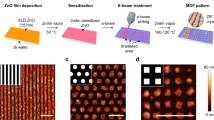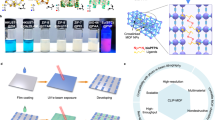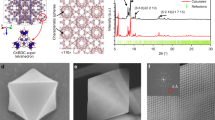Abstract
Metal–organic frameworks (MOFs) offer disruptive potential in micro- and optoelectronics because of the unique properties of these microporous materials. Nanoscale patterning is a fundamental step in the implementation of MOFs in miniaturized solid-state devices. Conventional MOF patterning methods suffer from low resolution and poorly defined pattern edges. Here, we demonstrate the resist-free, direct X-ray and electron-beam lithography of MOFs. This process avoids etching damage and contamination and leaves the porosity and crystallinity of the patterned MOFs intact. The resulting high-quality patterns have excellent sub-50-nm resolution, and approach the mesopore regime. The compatibility of X-ray and electron-beam lithography with existing micro- and nanofabrication processes will facilitate the integration of MOFs in miniaturized devices.
This is a preview of subscription content, access via your institution
Access options
Access Nature and 54 other Nature Portfolio journals
Get Nature+, our best-value online-access subscription
$29.99 / 30 days
cancel any time
Subscribe to this journal
Receive 12 print issues and online access
$259.00 per year
only $21.58 per issue
Buy this article
- Purchase on Springer Link
- Instant access to full article PDF
Prices may be subject to local taxes which are calculated during checkout





Similar content being viewed by others
Data availability
The data represented in Figs. 2a,b, 3 and 5c,d,h are provided with the paper as Source data. The image datasets are available from figshare (https://doi.org/10.6084/m9.figshare.12946922).
References
Aizenberg, J., Black, A. J. & Whitesides, G. M. Control of crystal nucleation by patterned self-assembled monolayers. Nature 398, 495–498 (1999).
Liddle, J. A. & Gallatin, G. M. Nanomanufacturing: a perspective. ACS Nano 10, 2995–3014 (2016).
Isaacoff, B. P. & Brown, K. A. Progress in top-down control of bottom-up assembly. Nano Lett. 17, 6508–6510 (2017).
Smith, K. H., Tejeda-Montes, E., Poch, M. & Mata, A. Integrating top-down and self-assembly in the fabrication of peptide and protein-based biomedical materials. Chem. Soc. Rev. 40, 4563–4577 (2011).
Liu, C.-C. et al. Directed self-assembly of block copolymers for 7 nanometre FinFET technology and beyond. Nat. Electron. 1, 562–569 (2018).
Batten, S. R. et al. Terminology of metal–organic frameworks and coordination polymers (IUPAC Recommendations 2013). Pure Appl. Chem. 85, 1715–1724 (2013).
Bennett, T. D. & Horike, S. Liquid, glass and amorphous solid states of coordination polymers and metal–organic frameworks. Nat. Rev. Mater. 3, 431–440 (2018).
Usman, M., Mendiratta, S. & Lu, K.-L. Semiconductor metal–organic frameworks: future low-bandgap materials. Adv. Mater. 29, 1605071 (2017).
Krishtab, M. et al. Vapor-deposited zeolitic imidazolate frameworks as gap-filling ultra-low-k dielectrics. Nat. Commun. 10, 3729 (2019).
Ryder, M. R. et al. Dielectric properties of zeolitic imidazolate frameworks in the broad-band infrared regime. J. Phys. Chem. Lett. 9, 2678–2684 (2018).
Lustig, W. P. et al. Metal–organic frameworks: functional luminescent and photonic materials for sensing applications. Chem. Soc. Rev. 46, 3242–3285 (2017).
Stassen, I. et al. An updated roadmap for the integration of metal–organic frameworks with electronic devices and chemical sensors. Chem. Soc. Rev. 46, 3185–3241 (2017).
Falcaro, P. et al. MOF positioning technology and device fabrication. Chem. Soc. Rev. 43, 5513–5560 (2014).
Ito, T. & Okazaki, S. Pushing the limits of lithography. Nature 406, 1027–1031 (2000).
Lu, G., Farha, O. K., Zhang, W., Huo, F. & Hupp, J. T. Engineering ZIF-8 thin films for hybrid MOF-based devices. Adv. Mater. 24, 3970–3974 (2012).
Stassen, I. et al. Chemical vapour deposition of zeolitic imidazolate framework thin films. Nat. Mater. 15, 304–310 (2016).
Okada, K. et al. Copper conversion into Cu(OH)2 nanotubes for positioning Cu3(BTC)2 MOF crystals: controlling the growth on flat plates, 3D architectures, and as patterns. Adv. Funct. Mater. 24, 1969–1977 (2014).
Dalstein, O. et al. Nanoimprinted, submicrometric, MOF-based 2D photonic structures: toward easy selective vapors sensing by a smartphone camera. Adv. Funct. Mater. 26, 81–90 (2016).
Razmjou, A. et al. Preparation of iridescent 2D photonic crystals by using a mussel-inspired spatial patterning of ZIF-8 with potential applications in optical switch and chemical sensor. ACS Appl. Mater. Interfaces 9, 38076–38080 (2017).
Wang, Y., Fedin, I., Zhang, H. & Talapin, D. V. Direct optical lithography of functional inorganic nanomaterials. Science 357, 385–388 (2017).
Garcia, R., Knoll, A. W. & Riedo, E. Advanced scanning probe lithography. Nat. Nanotechnol. 9, 577–587 (2014).
Nakayama, K. et al. High-mobility organic transistors with wet-etch-patterned top electrodes: a novel patterning method for fine-pitch integration of organic devices. Adv. Mater. Interfaces 1, 1300124 (2014).
Kumar, R., Singh, N., Chang, C. K., Dong, L. & Wong, T. K. S. Deep-ultraviolet resist contamination for copper/low-k dual-damascene patterning. J. Vac. Sci. Technol. B 22, 1052 (2004).
Baklanov, M. R. et al. Plasma processing of low-k dielectrics. J. Appl. Phys. 113, 041101 (2013).
Maldonado, J. R. & Peckerar, M. X-ray lithography: some history, current status and future prospects. Microelectron. Eng. 161, 87–93 (2016).
Chen, Y. Nanofabrication by electron beam lithography and its applications: a review. Microelectron. Eng. 135, 57–72 (2015).
Banerjee, R. et al. High-throughput synthesis of zeolitic imidazolate frameworks and application to CO2 capture. Science 319, 939–943 (2008).
Widmer, R. N. et al. X-ray radiation-induced amorphization of metal–organic frameworks. Phys. Chem. Chem. Phys. 21, 12389–12395 (2019).
Innocenzi, P., Malfatti, L., Marmiroli, B. & Falcaro, P. Hard X-rays and soft-matter: processing of sol–gel films from a top down route. J. Solgel Sci. Technol. 70, 236–244 (2014).
Schweinefuß, M. E. et al. Zeolitic imidazolate framework-71 nanocrystals and a novel SOD-type polymorph: solution mediated phase transformations, phase selection via coordination modulation and a density functional theory derived energy landscape. Dalton Trans. 43, 3528–3536 (2014).
Shen, K. et al. Ordered macro–microporous metal–organic framework single crystals. Science 359, 206–210 (2018).
Luo, Y., Ahmad, M., Schug, A. & Tsotsalas, M. Rising up: hierarchical metal–organic frameworks in experiments and simulations. Adv. Mater. 31, 1901744 (2019).
Choi, J. O., Moore, J. A., Corelli, J. C., Silverman, J. P. & Bakhru, H. Degradation of poly(methylmethacrylate) by deep ultraviolet, x‐ray, electron beam, and proton beam irradiations. J. Vac. Sci. Technol. B 6, 2286–2289 (1988).
Ihee, H. et al. Ultrafast X-ray diffraction of transient molecular structures in solution. Science 309, 1223–1227 (2005).
Yuan, R. et al. Chlorine-radical-mediated photocatalytic activation of C–H bonds with visible light. Angew. Chem. Int. Ed. 52, 1035–1039 (2013).
Lewandowski, M. & Ollis, D. F. Halide acid pretreatments of photocatalysts for oxidation of aromatic air contaminants: rate enhancement, rate inhibition, and a thermodynamic rationale. J. Catal. 217, 38–46 (2003).
Sivaguru, P., Wang, Z., Zanoni, G. & Bi, X. Cleavage of carbon–carbon bonds by radical reactions. Chem. Soc. Rev. 48, 2615–2656 (2019).
Cruz, A. J. et al. Integrated cleanroom process for the vapor-phase deposition of large-area zeolitic imidazolate framework thin films. Chem. Mater. 31, 9462–9471 (2019).
Japip, S., Liao, K.-S., Xiao, Y. & Chung, T.-S. Enhancement of molecular-sieving properties by constructing surface nano-metric layer via vapor cross-linking. J. Membr. Sci. 497, 248–258 (2016).
Taylor, A. W., Men, S., Clarke, C. J. & Licence, P. Acidity and basicity of halometallate-based ionic liquids from X-ray photoelectron spectroscopy. RSC Adv. 3, 9436–9445 (2013).
Hou, J. et al. Halogenated metal–organic framework glasses and liquids. J. Am. Chem. Soc. 142, 3880–3890 (2020).
Saitoh, R., Kanazawa, A., Kanaoka, S. & Aoshima, S. Cationic polymerization of p-methylstyrene using various metal chlorides: design rationale of initiating systems for controlled polymerization of styrenes. Polym. J. 48, 933–940 (2016).
Furukawa, S., Reboul, J., Diring, S., Sumida, K. & Kitagawa, S. Structuring of metal–organic frameworks at the mesoscopic/macroscopic scale. Chem. Soc. Rev. 43, 5700–5734 (2014).
Gangnaik, A. S., Georgiev, Y. M. & Holmes, J. D. New generation electron beam resists: a review. Chem. Mater. 29, 1898–1917 (2017).
Conrad, S. et al. Controlling dissolution and transformation of zeolitic imidazolate frameworks by using electron-beam-induced amorphization. Angew. Chem. Int. Ed. 57, 13592–13597 (2018).
Seo, E., Choi, B. K. & Kim, O. Determination of proximity effect parameters and the shape bias parameter in electron beam lithography. Microelectron. Eng. 53, 305–308 (2000).
Nathawat, R., Kumar, A., Acharya, N. K. & Vijay, Y. K. XPS and AFM surface study of PMMA irradiated by electron beam. Surf. Coat. Technol. 203, 2600–2604 (2009).
Li, K. et al. High speed e-beam writing for large area photonic nanostructures—a choice of parameters. Sci. Rep. 6, 32945 (2016).
Khay, I. et al. Assessment of the energetic performances of various ZIFs with SOD or RHO topology using high pressure water intrusion–extrusion experiments. Dalton Trans. 45, 4392–4400 (2016).
Zhang, K. et al. Alcohol and water adsorption in zeolitic imidazolate frameworks. Chem. Commun. 49, 3245–3247 (2013).
Dalstein, O. et al. Evaporation-directed crack-patterning of metal–organic framework colloidal films and their application as photonic sensors. Angew. Chem. Int. Ed. 56, 14011–14015 (2017).
Michalak, D. J. et al. Porosity scaling strategies for low-k films. J. Mater. Res. 30, 3363–3385 (2015).
Pérennès, F., De Bona, F. & Pantenburg, F. J. Deep X-ray lithography beamline at Elettra. Nucl. Instrum. Meth. A 467–468, 1274–1278 (2001).
Amenitsch, H. et al. First performance assessment of the small-angle X-ray scattering beamline at Elettra. J. Synchrotron Rad. 5, 506–508 (1998).
Hammersley, A. P., Svensson, S. O., Hanfland, M., Fitch, A. N. & Hausermann, D. Two-dimensional detector software: from real detector to idealised image or two-theta scan. High. Press. Res. 14, 235–248 (1996).
Blessing, R. H. An empirical correction for absorption anisotropy. Acta Cryst. A 51, 33–38 (1995).
Sheldrick, G. M. A short history of SHELX. Acta Cryst. A 64, 112–122 (2008).
Spek, A. L. Single-crystal structure validation with the program PLATON. J. Appl Cryst. 36, 7–13 (2003).
Spek, A. L. PLATON SQUEEZE: a tool for the calculation of the disordered solvent contribution to the calculated structure factors. Acta Cryst. C. 71, 9–18 (2015).
Nečas, D. & Klapetek, P. Gwyddion: an open-source software for SPM data analysis. Open Phys. 10, 181–188 (2011).
Horcas, I. et al. WSXM: A software for scanning probe microscopy and a tool for nanotechnology. Rev. Sci. Instrum. 78, 013705 (2007).
Tu, M., Wannapaiboon, S., Khaletskaya, K. & Fischer, R. A. Engineering zeolitic imidazolate framework (ZIF) thin film devices for selective detection of volatile organic compounds. Adv. Funct. Mater. 25, 4470–4479 (2015).
Le Ouay, B. et al. Nanostructuration of PEDOT in porous coordination polymers for tunable porosity and conductivity. J. Am. Chem. Soc. 138, 10088–10091 (2016).
Herzinger, C. M., Johs, B., McGahan, W. A., Woollam, J. A. & Paulson, W. Ellipsometric determination of optical constants for silicon and thermally grown silicon dioxide via a multi-sample, multi-wavelength, multi-angle investigation. J. Appl. Phys. 83, 3323–3336 (1998).
Eslava, S. et al. Characterization of a molecular sieve coating using ellipsometric porosimetry. Langmuir 23, 12811–12816 (2007).
Grzybowski, B. A., Qin, D. & Whitesides, G. M. Beam redirection and frequency filtering with transparent elastomeric diffractive elements. Appl. Opt. 38, 2997–3002 (1999).
Tanuma, S., Powell, C. J. & Penn, D. R. Calculation of electron inelastic mean free paths (IMFPs) VII. Reliability of the TPP-2M IMFP predictive equation. Surf. Interface Anal. 35, 268–275 (2003).
Acknowledgements
M.T. acknowledges the financial support from a Marie Skłodowska‐Curie Individual Fellowship (no. 708439, VAPOMOF). R.A. acknowledges funding from the European Research Council (no. 716472, VAPORE) and the Research Foundation Flanders (FWO) for funding in the research projects G083016N and 1501618N and the infrastructure project G0H0716N. P.F. acknowledges funding from the European Research Council (no. 771834, POPCRYSTAL) and LP-03. J.T. and S.D.F. acknowledge support by FWO and KU Leuven internal funds. M.L.T. acknowledges the financial support from an FWO senior postdoctoral fellowship (12ZK720N). D.E.K. acknowledges the Marie Skłodowska-Curie Training Network (no. 765378, HYCOAT) for the financial support. This work was additionally supported (Z.W. and R.A.F.) by the DFG Priority Program 1982 COORNETs (www.coornets.tum.de). This research project has received funding from the EU’s H2020 framework programme for research and innovation under grant agreements 801464 FETOPEN-1-2016-2017 and 654360 NFFA-Europe (proposal IDs 399, 462, 589, 596 and 854). T. Stassin and J. Marreiros are acknowledged for the help and discussions regarding the SAXS measurements. We thank E. Hedlund and M. Roeffaers for the assistance with the installation of the diffraction grating sensor setup, B. Raes and J. van de Vondel for the help with the EBL tool and M. Krishtab for the discussion on MOFs for low-k dielectrics.
Author information
Authors and Affiliations
Contributions
M.T. and R.A. conceived and designed the experiments. M.T. carried out and analysed film deposition, patterning and characterization experiments. M.T., B.X., D.E.K., M.J.V.H., A.T. and P.F. carried out bulk MOF synthesis and characterization. M.T., B.X., D.E.K., I.S. and B.M. carried out the XRL patterning. M.T., B.X., D.E.K. and H.A. carried out SAXS measurements. A.J.C and T.H. conducted the XPS measurements. M.T., J.T. and S.D.F contributed to the AFM measurements. M.T. and M.L.T. designed and conducted the diffraction grating sensing. Z.W. and R.A.F. conducted QCM measurements. The manuscript was written by M.T. and R.A., with the input of all authors.
Corresponding author
Ethics declarations
Competing interests
The authors declare no competing interests.
Additional information
Publisher’s note Springer Nature remains neutral with regard to jurisdictional claims in published maps and institutional affiliations.
Extended data
Extended Data Fig. 1 XRL-patterned 300 nm thick ZIF-71 films.
a, 3D optical profilometry of a ZIF-71 pattern (dumbbell shape), and the corresponding cross-section SEM images (b). c, 3D optical profilometry of a ZIF-71 patterns (square) and the corresponding top-view SEM images (d). e, 3D optical profilometry of a ZIF-71 patterns (hexagon) and the corresponding top-view SEM images (f).
Extended Data Fig. 2 XRL-patterned ZIF-8_Cl single crystals.
a, SEM image of pristine ZIF-8_dcIm single crystals. b, SEM image of ZIF-8_dcIm single crystals of which part has been cut away via XRL (red dashed box). c, SEM images of ZIF-8_dcIm single crystals after XRL patterning with a negative hexagonal grid mask. d-g, SEM images of ZIF-8_dcIm single crystals after XRL patterning with different shaped positive masks. All crystals were spread on double-sided Kapton tape on a Si wafer. Because of the weak adhesion between the crystals and the substrate, some patterned crystals were tilted or fell over (for example, the rod-shaped crystals in panel c) after development. The imprint on the substrate occurs because of the X-ray-induced damage of the Kapton tape.
Extended Data Fig. 3 EBL-patterned 100 nm thick ZIF-71 film.
SEM images of EBL-patterned ZIF-71 patterns with different sizes of trenches: a, 70 nm; b, 100 nm; c, 200 nm; d, 500 nm. SEM images of EBL-patterned ZIF-71 patterns with different sizes of square-shaped holes: e, 70 nm; f, 100 nm; g, 200 nm; h, 500 nm.
Supplementary information
Supplementary Information
Supplementary Information Sections 1–8, Figures 1–71, Tables 1–6 and references 1–37.
Source data
Source Data Fig. 2
Statistical Source Data.
Source Data Fig. 3
Statistical Source Data.
Source Data Fig. 5
Statistical Source Data.
Rights and permissions
About this article
Cite this article
Tu, M., Xia, B., Kravchenko, D.E. et al. Direct X-ray and electron-beam lithography of halogenated zeolitic imidazolate frameworks. Nat. Mater. 20, 93–99 (2021). https://doi.org/10.1038/s41563-020-00827-x
Received:
Accepted:
Published:
Issue Date:
DOI: https://doi.org/10.1038/s41563-020-00827-x
This article is cited by
-
Locally controlled MOF growth on functionalized carbon nanotubes
Communications Materials (2024)
-
Crosslinking-induced patterning of MOFs by direct photo- and electron-beam lithography
Nature Communications (2024)
-
Recent Advances in Patterning Strategies for Full-Color Perovskite Light-Emitting Diodes
Nano-Micro Letters (2024)
-
Unit-cell-thick zeolitic imidazolate framework films for membrane application
Nature Materials (2023)
-
Metal-organic framework template-guided electrochemical lithography on substrates for SERS sensing applications
Nature Communications (2023)



